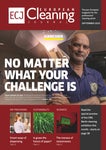Home › magazine › latest news › Invisible dirt, invisible risk: why high touch surface cleaning must evolve
Invisible dirt, invisible risk: why high-touch surface cleaning must evolve
21st of August 2025In environments where health and hygiene are crucial - such as care homes, hospitals, and public facilities - high-touch surfaces play a silent, but significant role in the transmission of infectious diseases.
Frequently touched surfaces are often missed in cleaning, even though they can spread infections through contact. Helge Alt from Puhastusekspert in Estonia and Tarja Valkosalo of Propuhtaus in Finland take a closer look in this piece for ECJ.
One study, for example, shows that a single surface can be touched by up to 40 people daily, and microbes can transfer to the fifth person who touches a contaminated surface-even if it looks clean. This highlights the urgent need for smarter, targeted cleaning strategies.
Identifying the invisible
Effective cleaning starts with understanding what needs to be cleaned. If we don't know which surfaces people actually touch, cleaning becomes guesswork. Door handles and light switches are always high-touch surfaces, frequently used by various individuals such as maintenance staff. However, other touchpoints vary depending on the mobility and activities of the client or patient.
For instance, a mobile resident may interact with doors, switches, and furniture, while a bedridden person may only come into contact with bed rails, call buttons, or nearby surfaces. Without conscious observation and mapping, even the best cleaning efforts may overlook real risks. Awareness is the foundation - without it, cleaning loses its impact.
Cleaning beyond the visible
Visual cleanliness doesn't equal microbial safety. In the PandemicClean.eu project, trained staff followed procedures carefully - yet 35 per cent of surfaces were more contaminated after cleaning. This surprising result shows that technique matters more than chemicals. Cloth hygiene, pressure and moisture must be correct; otherwise, even disinfectants fail.
Cleaning done with skill, evidence-based intervention and awareness can have measurable health benefits. For example, in one hospital setting - an Alexandris University clinical trial - enhanced cleaning and staff training were associated with a 40 per cent reduction in healthcare-associated infections (HAIs). While this is just one case, it illustrates how targeted cleaning practices may contribute to improved health outcomes.
Technique matters more than chemicals
Effective cleaning is not just about the products used, but how they are applied. A clean cloth, proper mechanical action and appropriate moisture levels are essential. Biofilms - complex layers of microbial growth - cannot be removed by disinfectants alone. If dirt remains, disinfectants are rendered ineffective.
Monitoring and accountability
Because we are dealing with invisible threats, objective measurement is crucial. Tools like ATP testing and microbial surface sampling provide quantifiable data on cleanliness. Without such measurements, it is impossible to give meaningful feedback about invisible contamination, which cannot be assessed by sight alone.
In a healthcare setting, removing invisible dirt and microbes is critically important, as these unseen contaminants can pose serious risks to vulnerable patients. Monitoring has been linked to reduced infection rates:for example, a study in Texas hospitals found that routine disinfection often left harmful microbes behind, underscoring the need for better oversight and validation.
Cleaning that protects health
Cleaning is a life-saving act, when carried out correctly. To ensure real impact, four elements are essential:
• Cleaning saves lives: proper cleaning can reduce infections-some hospitals have reported drops of up to 40 per cent
• Training is a smart investment: skilled staff deliver safer results
• Quality education matters: what and how we teach affects real-world performance
• Data and follow-up are key: monitoring and using real results in training drive lasting change.
Let's treat cleaning as a skilled, measurable, and impactful profession-because lives can depend on it.








